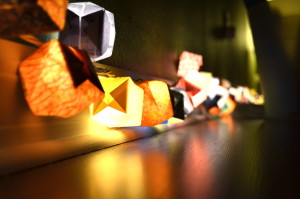What is Community Acupuncture?
Most US acupuncturists treat patients on tables in individual cubicles. This is not traditional in Asia, where acupuncture usually occurs in a community setting. In our clinic we use recliners and zero-gravity chairs in a large, quiet, soothing space. We primarily use distal points — points located from the knees to the toes, the elbows to the fingers, and on the head — so it is not necessary to change into a hospital gown to be treated. We only ask that you remove your shoes and socks and roll up your pant legs and sleeves.
Treating patients in a community setting has many benefits: it’s easy for friends and family members to come in for treatment together; many patients find it comforting; and a collective energetic field becomes established which actually makes individual treatments more powerful. In some styles of acupuncture, the needles are removed after only a few minutes or after a half hour at most. The style of acupuncture we practice at DCA allows patients to keep their needles in as long as they want, and the “right” amount of time varies from patient to patient. Most people learn after a few treatments when they feel “done;” this can take from twenty minutes to a couple of hours! Many people fall asleep and wake feeling refreshed.
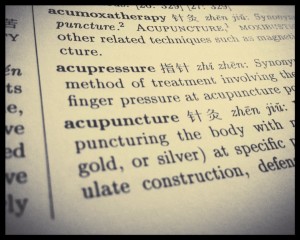
Is acupuncture safe?
Yes. The acupuncture needle is an extremely fine, single-use, sterile, FDA approved medical device. A licensed acupuncturist has undergone years of training in its safe implementation. Acupuncture has almost no negative side effects. There’s the chance of small bruise at the site of the needle, but this happens very rarely. (As someone who has been getting acupuncture about twice per week for ten years, MacKenzie has only bruised three times. Those are really good odds.)
How many treatments will I need?
Acupuncture is a process. Every now and then, acupuncture will act like a “miracle cure”, and a person will have all of their symptoms disappear after only one treatment – but that is a rare event. Acupuncture works by stimulating the body’s own self-healing mechanisms; it is gentle and safe and usually gradual. Almost everybody who gets acupuncture will need a series of treatments to get good, lasting results, which is the main reason we have our sliding scale. If you don’t come in often enough or long enough, acupuncture probably won’t work well for you. Your acupuncturist will suggest a treatment plan to you, meaning, how many treatments we think you will need to get good results; please let us know if you have any questions about your treatment plan, and please stick with it to the best of your ability. Depending on the nature, severity and duration of the complaint, the course of treatment will vary. Most acute problems can be fixed quickly, while more chronic conditions may be relieved only with time and effort. The speed of progress with long-standing chronic issues is much determined by the patient’s willingness to live and eat well in conjunction with the treatment. We recommend trying at least 6-10 treatments before evaluating how well acupuncture works for you.
Why do people get acupuncture?
Acupuncture can be used effectively for countless conditions — anything you would go to a Western Medical Doctor (MD) for can be treated with acupuncture. The ten most common reason people see an acupuncturist are: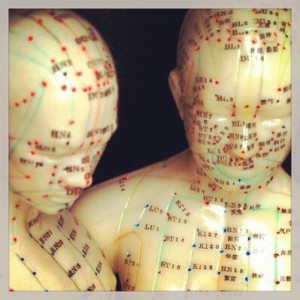
1. low back/hip pain
2. neck/shoulder pain
3. allergies
4. anxiety
5. headaches
6. depression
7. knee pain
8. digestive problems
9. sleep difficulties
10. fertility issues
I heard that the World Health Organization (WHO) approves of acupuncture. Is that true?
Acupuncture is recognized by the National Institutes of Health (NIH) and the World Health Organization (WHO) as effective in treating these conditions:
Addiction, anxiety, arthritis, asthma, bronchitis, carpal tunnel syndrome, chronic fatigue, colitis, common cold, constipation, dental pain, depression, diarrhea, digestive troubles, dizziness, eye problems, facial palsy and tics, fatigue, fertility, fibromyalgia, gingivitis, headaches and migraines, hiccough, incontinence, indigestion, irritable bowel syndrome (IBS), Meniere’s Disease, menopause, menstrual irregularities, morning sickness, nausea and vomiting, osteoarthritis, pain, PMS, pneumonia, rhinitis, sciatica, seasonal affective disorder (SAD), shoulder and wrist pain, sinusitis, sleep disturbances, smoking cessation, sore throat, stress, tennis elbow, tonsillitis, trigeminal neuralgia, and urinary tract infection (UTI).
Do I have to come for the rest of my life?
No. Or yes. It’s up to you. You don’t have to come for acupuncture for the rest of your life, but you do need to take care of yourself for the rest of your life, whether it’s by eating well, exercising, sleeping well, or living stress free. Acupuncture is one of the many tools we have access to that we can use to keep ourselves healthy. Most people will come in for treatment for a specific reason, and then realize after a few treatments that other things are improving, too, like their sleep or energy or mood. After we have focused on their primary complaint and they feel better, they may stop coming in for treatment as regularly, and drop by once or twice per month to keep themselves balanced and in good health. Some people come weekly for wellness treatments, and some come just because it is such a relaxing experience and they like having the opportunity to sit and be peaceful for a while. It’s your choice as to what role you want acupuncture to play in your healing process.
What happens during a treatment?
At your first visit, after you have completed the new patient paperwork, you will sit with the acupuncturist and talk about your health history. She will answer any questions you may have, and you will discuss your goals of treatment and together you will develop a treatment plan. Next, you will get acupuncture. After the needles are inserted you will sit for about 45 to 60 minutes. Most people feel very relaxed during their treatments, and some even fall asleep. If at any point you become uncomfortable, or you need a blanket or glass of water, just get the acupuncturist’s attention with a hand wave or head nod, and she will come over and help you. Don’t worry about the time—we keep track of that. Take advantage of this opportunity to relax and allow yourself to heal. When you decide your treatment is over (most people know when this is because they are done relaxing and start to feel ready to move around) gesture to the acupuncturist and they will come over and take your needles out. For follow up visits, just enter the treatment room quietly and make yourself comfortable. The acupuncturist will come over and you will chat for a few minutes, and then she will insert the needles. If you need to be out by a certain time let her know, or just give her a wave when you are done.
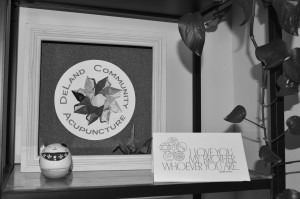 What does acupuncture feel like?
What does acupuncture feel like?
It feels great! Some people are concerned about the needles, but this is most likely because of their history with getting various shots or injections. Acupuncture is nothing like getting a shot. Acupuncture needles a very small and thin, about the width of a hair. Most of the time, you don’t even feel the needle being inserted. Sometimes it feels like a little mosquito bite, but that pain dissipates after a few seconds. If it doesn’t, let us know and we will adjust the needle.
Overall, acupuncture is a very relaxing experience. Some people even fall asleep during their treatment. People describe it different ways: a light, floating sensation; a warm or cool tingly sensation; a heavy moving sensation. It’s different for everyone, but overall, it’s relaxing. Sometimes during the first visit it is difficult to relax, but that’s because it’s a new experience and you’re nervous. You’ll probably relax just fine at your next visit.
Can acupuncture open my chakras?
No. The idea of chakras is part of Ayurvedic medicine, not Chinese Medicine. To have your chakras opened, you’d need to see an Ayurvedic practitioner. However, if you’re looking for a relaxing treatment that will help you feel open and more aligned, acupuncture can help with that.
What do I do if a needle falls out?
Don’t worry about it. Needles don’t fall out very often, and if they do it’s usually from the hand. The more you move during treatment, the better chance one will fall out. If you see where it falls, make a mental note of where it is, and we’ll make sure it gets picked up.
What if I have to use the restroom? Can I get up with the needles in?
DO NOT GET UP WITH THE NEEDLES IN! First, it will probably hurt. Second, needles will fall out and get lost and we don’t want anyone else stepping on them. Make sure you use the restroom before your treatment, since it’s hard to relax when you need to pee. If you really, really need to go and can’t want for your treatment to be over, just flag down the acupuncturist. She will take out the needles and you can go.
Can I answer my phone during my treatment?
No. Absolutely not. Never. First, there are people around you relaxing. Answering your phone will disrupt their treatment. Second, this is your opportunity to heal and take care of yourself. Turn your phone off and give yourself a chance to relax. This is the one rule we are firm about: If you answer your phone and disrupt the room, we will remove your needles and your treatment will be over. Please respect the community.
What should I expect to feel after treatment?
Depending on the issue for which you asked to be treated, its severity and whether it’s chronic or acute, you may find that you experience some immediate relief or notice no change. Relief may be dramatic or subtle; and it may be short-lived or last several days. For acute conditions you are more likely to feel immediate relief during the treatment and/or in the few hours following it. For chronic conditions the changes may be subtle or not noticeable right away. Occasionally (in about 5-10% of cases) the issue being treated gets worse for 24 hours following the session, followed by great relief.
Is there anything in particular I should pay attention to?
Particularly in the 24-48 hours after your treatment, it is a good idea to pay attention to the way you feel in regards to the main condition(s) you’ve sought treatment for as well as to other systems of the body. Because acupuncture is holistic and most acupuncture points can be used to treat a multitude of conditions, numerous changes may occur, including better spirits, relaxation, greater energy, improved digestion and more restful sleep in addition to relief from the main condition(s) you’ve been treated for.
How do I know if it’s working?
Do you feel any better? Are you sleeping better? Have there been improvements in your energy and digestion? Are you dealing with stress better? Is your pain less? Any improvements in health can be an indication that acupuncture is having a positive result. An important thing to remember about healing is that there isn’t always a straight line from sick to being healthy. There will be days where you feel better than others, but overall, you should feel a steady improvement in your energy, sleep, digestion, mood and pain. With time, acupuncture can help restore health and vitality, and improve the quality of your life.
My last acupuncturist did points on my back. Why don’t you do back points?
Because we don’t have to. There are dozens of styles of acupuncture (Chinese, Japanese, Korean Hand, Auricular, French, Vietnamese, French Vietnamese, Tung, Tan, and Five Element to name only a few). We primarily practice a style called Meridian Theory. One of the best things about Meridian Theory is that you don’t need to use points near the pain to treat the pain. Some of the best points for back pain are on the hands and feet; for headaches they are on the feet; for shoulder pain they are near the knees. By utilizing this style of acupuncture, we can treat people in a community setting without them having to change into hospital gowns or having their bodies exposed.
I don’t feel well. Should I cancel my appointment?
If you’re feeling really horrible, with a cold, the flu, vomiting, or diarrhea, and you feel like the pain and discomfort is too bad to drive, then yes, feel free to cancel your appointment. We don’t want you to drive here and risk injuring yourself in the process.
What’s the difference between private acupuncture and community acupuncture?
In private settings, the practitioner will typically spend 30-45 minutes on an intake, assessment and consultation. The client is then treated in a private room, usually on a massage table. Sometimes there may be needles inserted both on the front and the back of the body. The private acupuncturist may provide additional therapies, such as cupping, massage, and moxibustion, and may recommend lifestyle changes. The needle retention time is usually precisely limited in this setting, as the private room may need to be available for the next appointment.
In community acupuncture, we strip away all of the “extras” and provide you with quality acupuncture at a price you can afford. We don’t have a receptionist. We use an online scheduler which we encourage everyone to use and we have a self-pay station in the waiting room. We don’t provide massage, but we have business cards for our favorite LMTs. We don’t do herbal formulas, because we know that most people can’t afford them, and because we believe that it’s best to start with dietary changes. Our community acupuncture clinic is set up similarly to acupuncture clinics in many Asian countries. Because we have a high-volume clinic, we get a lot of practice giving a wide variety of treatments every single day. We are skilled in making a quick and efficient assessment and providing an effective personalized treatment. We specifically study acupuncture methods well-suited for delivering results in a community setting in order to offer skilled care at affordable rates to more people. However, we are usually not able to offer any one client extra consultation time or additional modalities, except for occasional dietary or lifestyle suggestions.
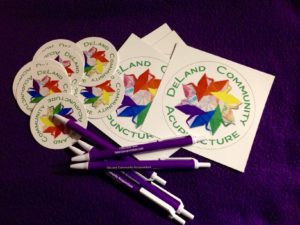 We encourage our clients to take a deep rest during their acupuncture sessions and to decide on their own how long they wish to relax after needle insertion. Many of our clients report significant benefits from being allowed to self-regulate the length of time for resting with the needles.
We encourage our clients to take a deep rest during their acupuncture sessions and to decide on their own how long they wish to relax after needle insertion. Many of our clients report significant benefits from being allowed to self-regulate the length of time for resting with the needles.
For those who prefer more privacy and more “talking time” along with their acupuncture, there are many excellent practitioners in Volusia County offering private treatments.
What don’t you do?
Put needles in your back. THIS DOES NOT MEAN THAT WE DON’T TREAT BACK PAIN. Back pain is the #1 complaint we see at the clinic. Some of the best points for back pain are on the hands and feet, which we are able to access in a community setting.
Use Massage Tables. Our clinic has 10 zero gravity chairs and recliners, with plenty of pillows, blankets, and bolsters to help you get comfortable.
Provide Private Consultation. During your first visit, we will talk chair-side for about 10-15 minutes and then you will receive your acupuncture treatment. On follow-up visits, we will talk briefly about your progress before your treatment. With music and white noise machines in the treatment room, it’s difficult for the person resting next to you to hear what you are saying. Plus, there is a very good chance that they have fallen asleep or are listening to their own music with earbuds.
Provide Lifestyle Or Psychological Counseling. Our focus is to provide all our clients with efficient high quality acupuncture. If we feel that a dietary or lifestyle change would benefit you, we have printed material that we can give you instead of having a long discussion about it. We find that giving you something to take home and read is actually more effective than just making a suggestion; it will give you time to review it and process it when you have more time.
We Are Not Always Equipped to Change Money. We do not keep money sitting around the clinic and are only able to provide change if our acupuncturist just happens to have cash. Please have the exact amount you wish to pay in our sliding scale ready when you come in for treatment.
What do you mean I can pay what I want?
That’s right. You pay what works for you on a sliding scale of $15 to $35 per treatment.
For thousands of years, acupuncture has been a “people’s medicine”: low-tech, inexpensive, easily available, and very quiet. Only in the US in the last thirty years did acupuncture become a luxury item for only wealthy people, with a cost of $50 to $250 per treatment, individual treatment rooms, and lots of talking. We have eliminated the unnecessary talking and the unnecessarily high prices.
There is a one-time $10 new patient paperwork fee with your first appointment. Acupuncture appointments are on a sliding scale of $15-$35 per treatment. You don’t get more if you pay more. Everyone gets the treatment the acupuncturist thinks they need, and everyone pays what works for them. Please pay us whatever you feel comfortable with on that scale, keeping in mind that you may need a series of treatments. If the cost of treatment is an issue, please let us know before discontinuing treatment. Our goal is to make acupuncture accessible and affordable; we want you to come in often enough to get better and stay better. We understand that everyone’s situation is different, and our primary goal is to make acupuncture available to you as often as you need it.
We have no relationship with insurance companies, because insurance companies do not like sliding scales.
Is there anything I should know before my first visit?
- As a courtesy to our allergy patients, we ask that you please do not wear strong perfumes or colognes, or smoke cigarettes at least two hours beforehand, when coming to the clinic.
- If you are able to, please print the New Patient Paperwork from the website or introductory email, complete it at home, and bring it with you to your treatment. This will allow us to get your treatment started sooner. If you are unable to print the paperwork beforehand, we ask that you arrive at least ten minutes early so it can be completed before your scheduled appointment time.
- Bring a list of: all medications and supplements you are taking, any diagnosed medical conditions, and any surgeries or significant traumas/accidents you have had. If you print and complete the paperwork beforehand, you may write this information on the back.
- Wear loose clothing. We do primarily distal points (points located on the arms, the knees to the feet, and on the head and neck). We need access to these areas of the body.
- Do not drink coffee or other caffeinated beverages at least 5 hours before your appointment. You’re coming here to relax. Caffeine can interfere with that.
- Have a light meal or snack before the visit. Heavy meals can cause nausea. An empty stomach can be the cause of dizziness after a treatment.
- Do not eat or drink food that changes the color of your tongue, and do not drink alcohol.
- Remember that you are being treated at a community acupuncture clinic. This means that other people will be receiving treatment at the same time as you. The space is quiet and peaceful, with low lighting and soft music. If you would like, you may bring your mp3 player and earbuds, or a book to read, although most people find the treatment too relaxing to read during.
There isn’t a receptionist in your waiting room. What do I do?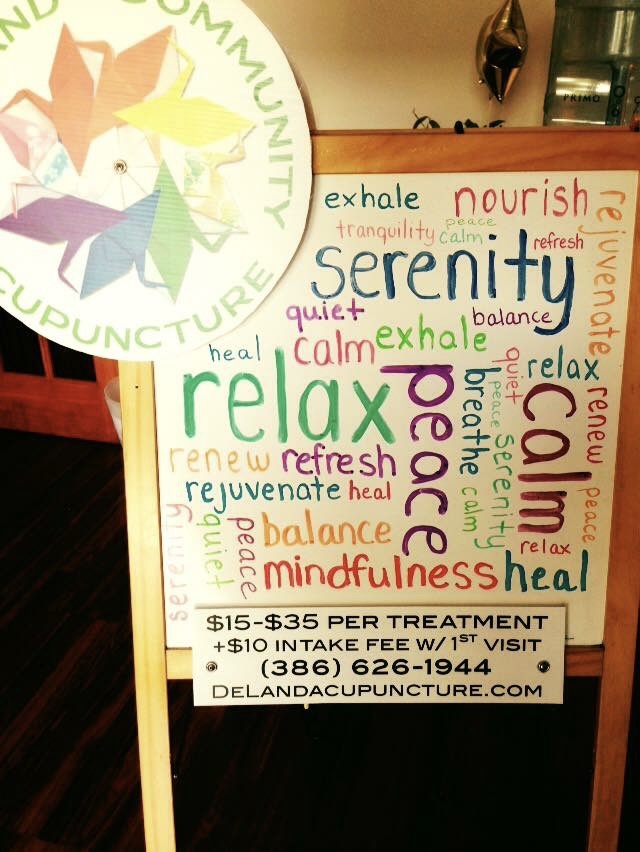
For your first visit, silence your cell phone before entering the clinic. If you’ve completed the paperwork, have a seat in the waiting room. Help yourself to tea or water. You don’t need to enter the treatment room. We know you are here. We heard you come in. Don’t worry about the self-pay station at the desk. We will show you how to do that after your first treatment. If you haven’t completed the paperwork, grab a clipboard from the pocket above the desk and fill it out. Make yourself comfortable. We will be with your shortly.
For returning visits, again, please silence your cell phone before entering the clinic. You do not need to sit in the waiting room and wait for us to call you in. Stop at the self-pay station and pay for your treatment, then enter the treatment room quietly. If you need to use the restroom, please do so, then make yourself comfortable in the chair of your choosing. We will be with your shortly. If you chose to not use the online scheduler and want us to make your next appointment for you, please let us know when you would like to return at the start of your treatment. This way we can look at the schedule when we have a moment between patients.
Do I have to make an appointment?
Yes. We do not take walk-ins.
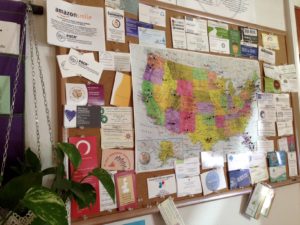 I called several times and no one answered. Do you ever answer your phone?
I called several times and no one answered. Do you ever answer your phone?
Yes. First, we have limited hours, and odds are the time you called we were closed. Second, when we are open, we’re busy, and we can’t always get to the phone. That’s one of the reasons we encourage people to use the online scheduler; it allows you to make, change, and cancel appointments without having to call the clinic. You can leave a message if you’d like, but be aware that it may take up to 48 hours to return your call. Occasionally we can answer the phone or return calls during the shift, but that doesn’t happen often. A receptionist is an added expense – the online scheduler is one of the many systems we use to keep our prices so low.
What’s the easiest/fastest way to get in touch with you?
Email: delandcomacu@gmail.com

